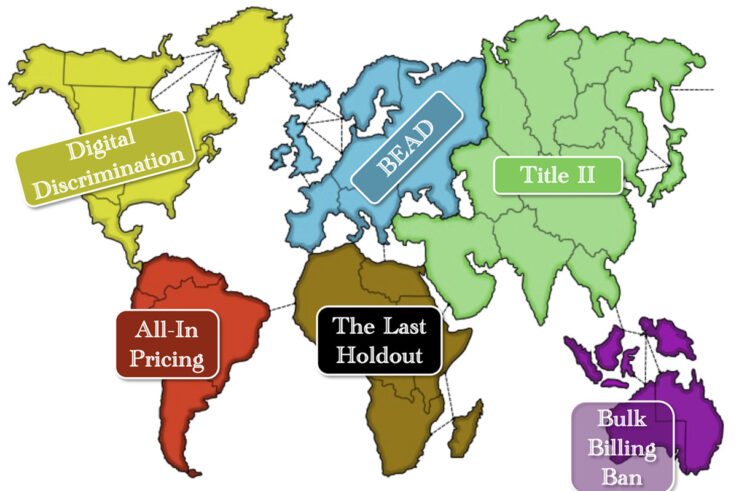[I am participating in an online “debate” at the American Constitution Society with Professor Ben Edelman. The debate consists of an opening statement and concluding responses to be posted later in the week. Professor Edelman’s opening statement is here. I am cross-posting my opening statement here at TOTM. This is my closing statement]
Professor Edelman’s opening post does little to support his case. Instead, it reflects the same retrograde antitrust I criticized in my first post.
Edelman’s understanding of antitrust law and economics appears firmly rooted in the 1960s approach to antitrust in which enforcement agencies, courts, and economists vigorously attacked novel business arrangements without regard to their impact on consumers. Judge Learned Hand’s infamous passage in the Alcoa decision comes to mind as an exemplar of antitrust’s bad old days when the antitrust laws demanded that successful firms forego opportunities to satisfy consumer demand. Hand wrote:
we can think of no more effective exclusion than progressively to embrace each new opportunity as it opened, and to face every newcomer with new capacity already geared into a great organization, having the advantage of experience, trade connections and the elite of personnel.
Antitrust has come a long way since then. By way of contrast, today’s antitrust analysis of alleged exclusionary conduct begins with (ironically enough) the U.S. v. Microsoft decision. Microsoft emphasizes the difficulty of distinguishing effective competition from exclusionary conduct; but it also firmly places “consumer welfare” as the lodestar of the modern approach to antitrust:
Whether any particular act of a monopolist is exclusionary, rather than merely a form of vigorous competition, can be difficult to discern: the means of illicit exclusion, like the means of legitimate competition, are myriad. The challenge for an antitrust court lies in stating a general rule for distinguishing between exclusionary acts, which reduce social welfare, and competitive acts, which increase it. From a century of case law on monopolization under § 2, however, several principles do emerge. First, to be condemned as exclusionary, a monopolist’s act must have an “anticompetitive effect.” That is, it must harm the competitive process and thereby harm consumers. In contrast, harm to one or more competitors will not suffice.
Nearly all antitrust commentators agree that the shift to consumer-welfare focused analysis has been a boon for consumers. Unfortunately, Edelman’s analysis consists largely of complaints that would have satisfied courts and agencies in the 1960s but would not do so now that the focus has turned to consumer welfare rather than indirect complaints about market structure or the fortunes of individual rivals.
From the start, in laying out his basic case against Google, Edelman invokes antitrust concepts that are simply inapt for the facts and then goes on to apply them in a manner inconsistent with the modern consumer-welfare-oriented framework described above:
In antitrust parlance, this is tying: A user who wants only Google Search, but not Google’s other services, will be disappointed. Instead, any user who wants Google Search is forced to receive Google’s other services too. Google’s approach also forecloses competition: Other sites cannot compete on their merits for a substantial portion of the market – consumers who use Google to find information – because Google has kept those consumers for itself.
There are two significant errors here. First, Edelman claims to be interested in protecting users who want only Google Search but not its other services will be disappointed. I have no doubt such consumers exist. Some proof that they exist is that a service has already been developed to serve them. Professor Edelman, meet Googleminusgoogle.com. Across the top the page reads: “Search with Google without getting results from Google sites such as Knol, Blogger and YouTube.” In antitrust parlance, this is not tying after all. The critical point, however, is that user preferences are being satisfied as one would expect to arise from competition.
The second error, as I noted in my first post, is to condemn vertical integration as inherently anticompetitive. It is here that the retrograde character of Professor Edelman’s analysis (and other critics of Google, to be fair) shines brightest. It reflects a true disconnect between the 1960s approach to antitrust which focused exclusively upon market structure and impact upon rival websites; impact upon consumers was nowhere to be found. That Google not only produces search results but also owns some of the results that are searched is not a problem cognizable by modern antitrust. Edelman himself—appropriately—describes Google and its competitors as “information services.” Google is not merely a URL finder. Consumers demand more than that and competition forces search engines to deliver. It offers value to users (and thus it can offer users to advertisers) by helping them find information in increasingly useful ways. Most users “want Google Search” to the exclusion of Google’s “other services” (and, if they do, all they need do is navigate over to http://googleminusgoogle.com/ (even in a Chrome browser) and they can have exactly that). But the critical point is that Google’s “other services” are methods of presenting information to consumers, just like search. As the web and its users have evolved, and as Google has innovated to keep up with the evolving demands of consumers, it has devised or employed other means than simply providing links to a set of URLs to provide the most relevant information to its users. The 1960s approach to antitrust condemns this as anticompetitive foreclosure; the modern version recognizes it as innovation, a form of competition that benefits consumers.
Edelman (and other critics, including a number of Senators at last month’s hearing) hearken back to the good old days and suggest that any deviation from Google’s technology or business model of the past is an indication of anticompetitive conduct:
The Google of 2004 promised to help users “leave its website as quickly as possible” while showing, initially, zero ads. But times have changed. Google has modified its site design to encourage users to linger on other Google properties, even when competing services have more or better information. And Google now shows as many fourteen ads on a page.
It is hard to take seriously an argument that turns on criticizing a company simply for looking different than it did seven years ago. Does anybody remember what search results looked like 7 years ago? A theory of antitrust liability that would condemn a firm for investing billions of dollars in research and product development, constantly evolving its product to meet consumer demand, taking advantage of new technology, and developing its business model to increase profitability should not be taken seriously. This is particularly true where, as here, every firm in the industry has followed a similar course, adopting the same or similar innovations. I encourage readers to try a few queries on http://www.bing-vs-google.com/– where you can get side by side comparisons – in order to test whether the evolution of search results and innovation to meet consumer preferences is really a Google-specific thing or an industry wide phenomenon consistent with competition. Conventional antitrust analysis holds that when conduct is engaged in not only by allegedly dominant firms, but also by every other firm in an industry, that conduct is presumptively efficient, not anticompetitive.
The main thrust of my critique is that Edelman and other Google critics rely on an outdated antitrust framework in which consumers play little or no role. Rather than a consumer-welfare based economic critique consistent with the modern approach, these critics (as Edelman does in his opening statement) turn to a collection of anecdotes and “gotcha” statements from company executives. It is worth correcting a few of those items here, although when we’ve reached the point where identifying a firm’s alleged abuse is a function of defining what a “confirmed” fax is, we’ve probably reached the point of decreasing marginal returns. Rest assured that a series of (largely inaccurate) anecdotes about Google’s treatment of particular websites or insignificant contract terms is wholly insufficient to meet the standard of proof required to make a case against the company under the Sherman Act or even the looser Federal Trade Commission Act.
- It appears to be completely inaccurate to say that “[a]n unsatisfied advertiser must complain to Google by ‘first class mail or air mail or overnight courier’ with a copy by ‘confirmed facsimile.’” A quick search, even on Bing, leads one to this page, indicating that complaints may be submitted via web form.
- It is likewise inaccurate to claim that “advertisers are compelled to accept whatever terms Google chooses to impose. For example, an advertiser seeking placement through Google’s premium Search Network partners (like AOL and The New York Times) must also accept placement through the entire Google Search Network which includes all manner . . . undesirable placements.” In actuality, Google offers a “Site and Category Exclusion Tool” that seems to permit advertisers to tailor their placements to exclude exactly these “undesirable placements.”
- “Meanwhile, a user searching for restaurants, hotels, or other local merchants sees Google Places results with similar prominence, pushing other information services to locations users are unlikely to notice.” I have strived in vain to enter a search for a restaurant, hotel, or the like into Google that yielded results that effectively hid “other information services” from my notice, but for some of my searches, Google Places did come up first or second (and for others it showed up further down the page).
- Edelman has noted elsewhere that, sometimes, for some of the searches he has tested, the most popular result on Google (as well, I should add, on other, non-“dominant” sites) is not the first, Google-owned result, but instead the second. He cites this as evidence that Google is cooking the books, favoring its own properties when users actually prefer another option. It actually doesn’t demonstrate that, but let’s accept the claim for the sake of argument. Notice what his example also demonstrates: that users who prefer the second result to the first are perfectly capable of finding it and clicking on it. If this is foreclosure, Google is exceptionally bad at it.
The crux of Edelman’s complaint seems to be that Google is competing in ways that respond to consumer preferences. This is precisely what antitrust seeks to encourage, and we would not want a set of standards that chilled competition because of a competitor’s success. Having been remarkably successful in serving consumers’ search demands in a quickly evolving market, it would be perverse for the antitrust laws to then turn upon Google without serious evidence that it had, in fact, actually harmed consumers.
Untethered from consumer welfare analysis, antitrust threatens to re-orient itself to the days when it was used primarily as a weapon against rivals and thus imposed a costly tax on consumers. It is perhaps telling that Microsoft, Expedia, and a few other Google competitors are the primary movers behind the effort to convict the company. But modern antitrust, shunning its inglorious past, requires actual evidence of anticompetitive effect before condemning conduct, particularly in fast-moving, innovative industries. Neither Edelman nor any of Google’s other critics, offer any.
During the heady days of the Microsoft antitrust case, the big question was whether modern antitrust would be able to keep up with quickly evolving markets. The treatment of the proferred case against Google is an important test of the proposition (endorsed by the Antitrust Modernization Commission and others) that today’s antitrust is capable of consistent and coherent application in innovative, high-tech markets. An enormous amount is at stake. Faced with the high stakes and ever-evolving novelty of high-tech markets, antitrust will only meet this expectation if it remains grounded and focused on the core principle of competitive effects and consumer harm. Without it, antitrust will devolve back into the laughable and anti-consumer state of affairs of the 1960s—and we will all pay for it.




